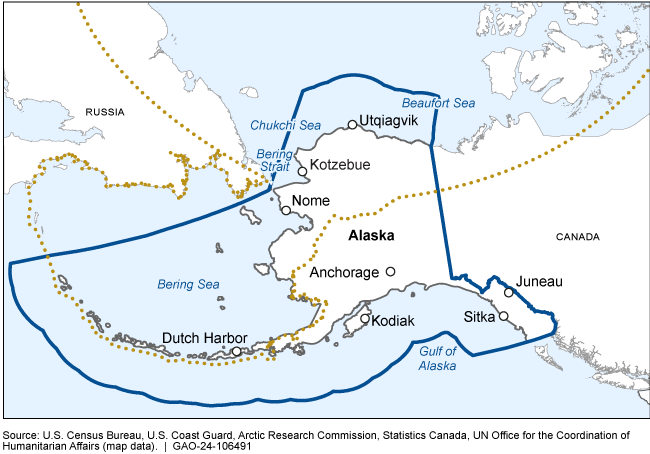Coast Guard: Complete Performance and Operational Data Would Better Clarify Arctic Resource Needs
Fast Facts
The United States, by virtue of Alaska, is an Arctic nation.
The Coast Guard has assessed evolving risks in the region—including geopolitical tensions and climate change—and has taken steps to manage them. For example, it deployed ships to the area and participates in training exercises. But it hasn't always spent as much time as it planned for these activities.
The Coast Guard hasn't fully tracked the time spent on its Arctic activities. Complete information would help the Coast Guard better allocate its constrained resources and assess its progress toward achieving its Arctic strategic goals.
Our recommendations address these issues.
Coast Guard District 17 Area of Operations

Highlights
What GAO Found
The Coast Guard has assessed risks, such as from climate change and increased maritime activity, that affect its ability to carry out its missions in the U.S. Arctic region. It has also identified these risks in various planning documents, including the Coast Guard Arctic strategy.
The Coast Guard manages Arctic risks like responding to maritime incidents by forward deploying cutter and aviation assets into the U.S. Arctic region to reduce its transit and response times. The Coast Guard also deploys assets to provide a presence there but has not always been able to meet its planned deployment commitments recently. Coast Guard reports for the region that document asset resource use and mission performance for operational planning did not have complete information from fiscal year 2016 through fiscal year 2021. For example, some years did not include targets for key missions (e.g., maritime law enforcement). Reports were also unavailable for fiscal years 2022 and 2023. Collecting and reporting complete information would better position the Coast Guard to make more informed operational planning decisions for the region.
Additionally, the Coast Guard Arctic implementation plan outlines initiatives and actions that it intends to take to execute strategic objectives identified in its Arctic strategy and to support the national Arctic strategy. However, the plan generally does not include key metrics such as performance measures, targets, or time frames for action items. This may make it difficult for the Coast Guard to plan activities, determine resource needs, assess its progress toward strategic objectives, and ensure its efforts are aligned with national efforts.
Coast Guard Polar Icebreaker Healy

The Coast Guard and Department of Defense (DOD) described collaborating in the Arctic to assess and manage risks in several ways, including sharing relevant information and expertise and providing operational assistance. For example, both agencies collaborated on the development of their Arctic strategies and collaborate to improve domain awareness in the Arctic. They also provide operational support to each other, such as the Coast Guard providing search and rescue coverage for DOD during a biennial exercise.
Why GAO Did This Study
The United States, by virtue of Alaska, is an Arctic nation with substantial regional interests. Increasing Arctic activity, risks, and geopolitical tensions mean that the Coast Guard and its key federal partners, such as DOD, face growing responsibilities. These include assessing and managing risks to maritime safety, security, and environment, as well as to non-maritime national security.
The James M. Inhofe National Defense Authorization Act for Fiscal Year 2023 includes a provision for GAO to review Coast Guard Arctic operations and infrastructure. This report addresses (1) the extent to which the Coast Guard has assessed and planned for its Arctic risks, and identified the resources needed to do so, and (2) how the Coast Guard has collaborated with DOD to assess and manage Arctic risks. GAO reviewed and analyzed Coast Guard risk assessment and management and performance documents and interviewed officials from the Coast Guard, DOD, and other relevant Arctic stakeholders, including White House, State of Alaska, and Alaska Native officials.
Recommendations
GAO is recommending that Coast Guard ensure that (1) it collects and reports complete information about resource use and mission performance, and (2) its Arctic implementation plan includes performance measures with associated targets and timeframes for action items. The Department of Homeland Security concurred with both recommendations and identified planned actions to address them.
Recommendations for Executive Action
| Agency Affected | Recommendation | Status |
|---|---|---|
| United States Coast Guard | The Commandant of the Coast Guard should ensure that District 17 collects and reports complete information about resource use and mission performance in accordance with Coast Guard guidance. (Recommendation 1) |
The Department of Homeland Security concurred with this recommendation. It stated that Coast Guard District 17 has integrated the practice of reviewing the status of its Operational Assessment Reports and associated deadlines into bi-weekly leadership meetings to ensure cross-department visibility and collaboration. In addition, guidance contained in the Operation Planning Direction will be condensed and distributed to subordinate operational units on a quarterly basis. These actions will better enable the collection and reporting of complete information about resource use and mission performance in accordance with Coast Guard guidance. The stated estimated completion date is December 31, 2024.
|
| United States Coast Guard | The Commandant of the Coast Guard should ensure that the Coast Guard's Arctic implementation plan includes performance measures with associated targets and time frames for the action items described in the plan in accordance with Coast Guard guidance. (Recommendation 2) |
The Department of Homeland Security concurred with this recommendation. It stated that the Coast Guard's Polar Coordination Office (CG-PCO) will coordinate actions to address this recommendation by incorporating milestones into the program and project execution plans associated with action items described in ASIP as they are developed. It further stated that the CG-PCO will capture the advancement of Arctic strategic objectives, which will be tracked and shared with Coast Guard leadership, as appropriate. The stated estimated completion date is November 30, 2024.
|
